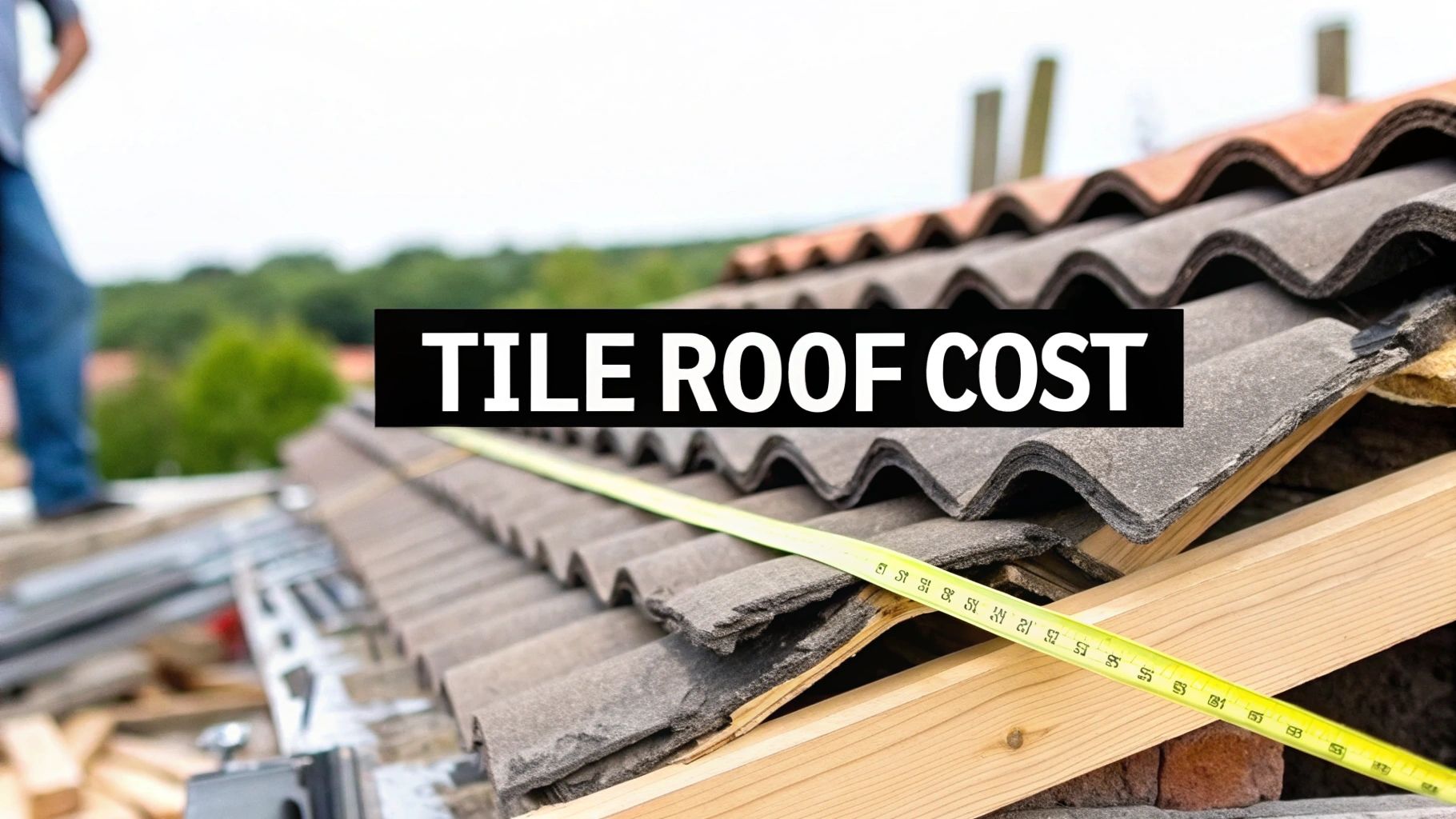Trying to pin down the final price for a new tile roof can feel like chasing a moving target. To give you a clear starting point, a professional tile roof replacement cost in our area generally runs between $7 and $25 per square foot. For most South Florida homeowners, that means a total project investment somewhere between $10,500 and $62,500.
That’s a big range. The final cost depends directly on the materials you choose and the size and complexity of your roof. This guide will give you the actionable insights you need to navigate this investment wisely.
Your Quick Answer to Tile Roof Costs
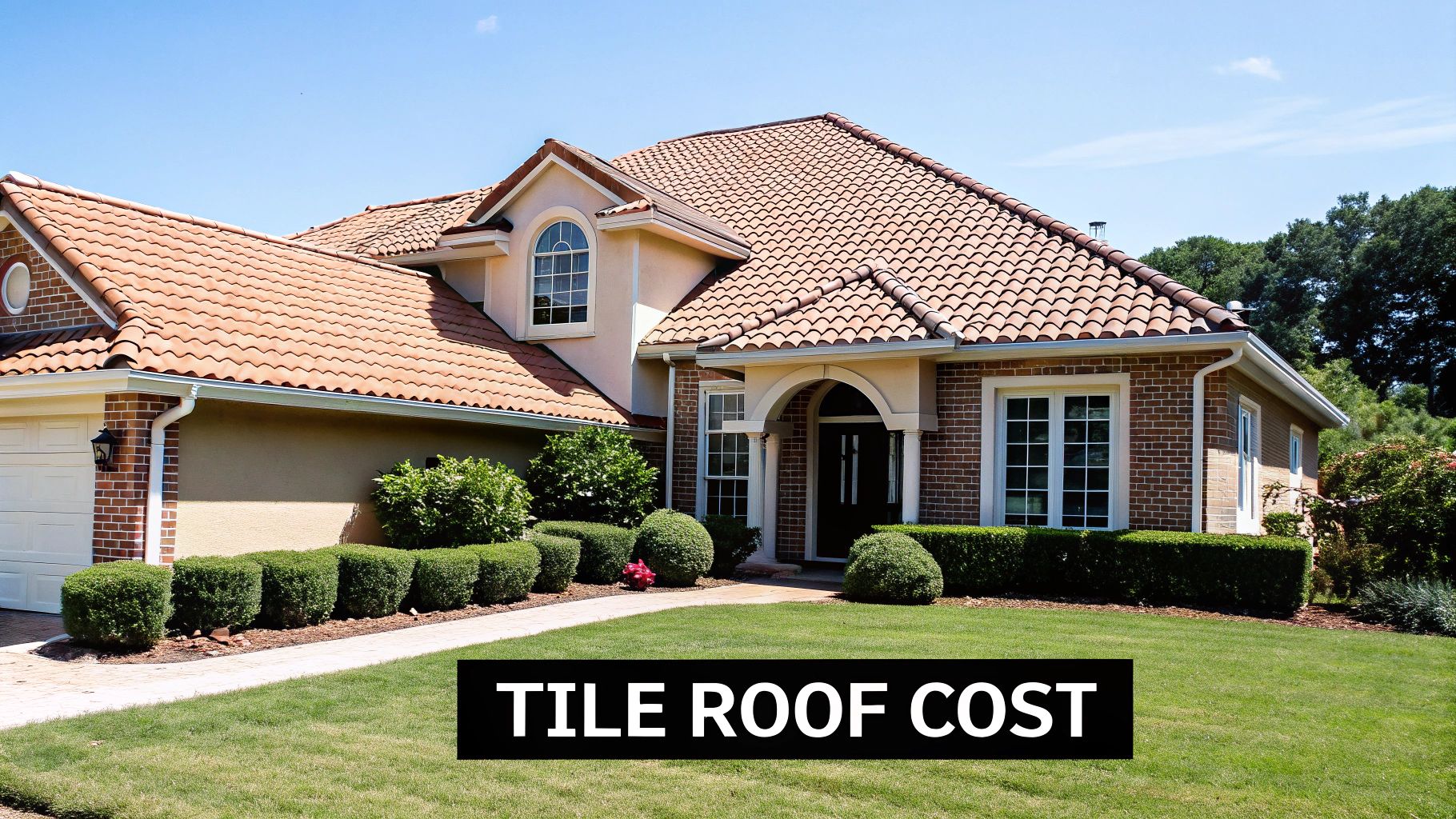
When budgeting for this project, it's practical to start with a realistic average. A typical tile roof replacement often lands around the $16,000 mark. However, this figure is heavily influenced by the type of tile you select—concrete, clay, or slate—and the specific challenges of your roof's design.
Let's translate that into numbers you can use for planning. Industry data shows a complete tile roof can start as low as $8,200 for a smaller, simpler home using budget-friendly materials. On the other end, it can easily climb to $24,600 or more for larger homes with premium tiles. A key action item for your budget is to remember that labor will typically account for 40% of the total cost. If you want to benchmark these figures, you can learn more about these roofing cost breakdowns and see how they compare nationwide.
A Snapshot of Potential Costs
To budget effectively, your first step is to understand the cost differences between tile materials. Concrete tiles are your most affordable option, while classic slate represents the peak of both performance and price. The second step is to measure or find the square footage of your roof.
The table below combines these two factors to provide a quick-reference guide for your initial budget. Use it to estimate your potential investment based on common South Florida home sizes and the three main tile options.
Key Takeaway: Your choice of tile material is the single biggest factor driving your total roof replacement cost. Right behind it are your home's square footage and the unique complexities of the installation.
Estimated Tile Roof Replacement Cost by Material and Size
Use this table to get a practical, ballpark estimate for your project. Find your approximate roof size and compare the cost ranges for each material to see what aligns with your budget.
| Roof Size (Square Feet) | Concrete Tile Cost Range | Clay Tile Cost Range | Slate Tile Cost Range |
|---|---|---|---|
| 1,500 sq. ft. | $12,000 – $22,500 | $15,000 – $30,000 | $18,000 – $37,500 |
| 2,000 sq. ft. | $16,000 – $30,000 | $20,000 – $40,000 | $24,000 – $50,000 |
| 2,500 sq. ft. | $20,000 – $37,500 | $25,000 – $50,000 | $30,000 – $62,500 |
| 3,000 sq. ft. | $24,000 – $45,000 | $30,000 – $60,000 | $36,000 – $75,000 |
Disclaimer: These figures are solid estimates for initial planning. To get a firm, precise quote you can sign, you must have a professional roofer conduct a hands-on inspection of your property.
What Really Drives Your Final Roofing Bill
When you review two quotes for the same tile roof, the price difference is always in the details. A roofing estimate is built in layers. While the tiles are the largest single expense, factors like labor rates, roof complexity, and essential add-on services significantly impact the bottom line. Understanding these components is your key to confidently evaluating any proposal.
This graphic breaks down the main cost drivers you need to be aware of.
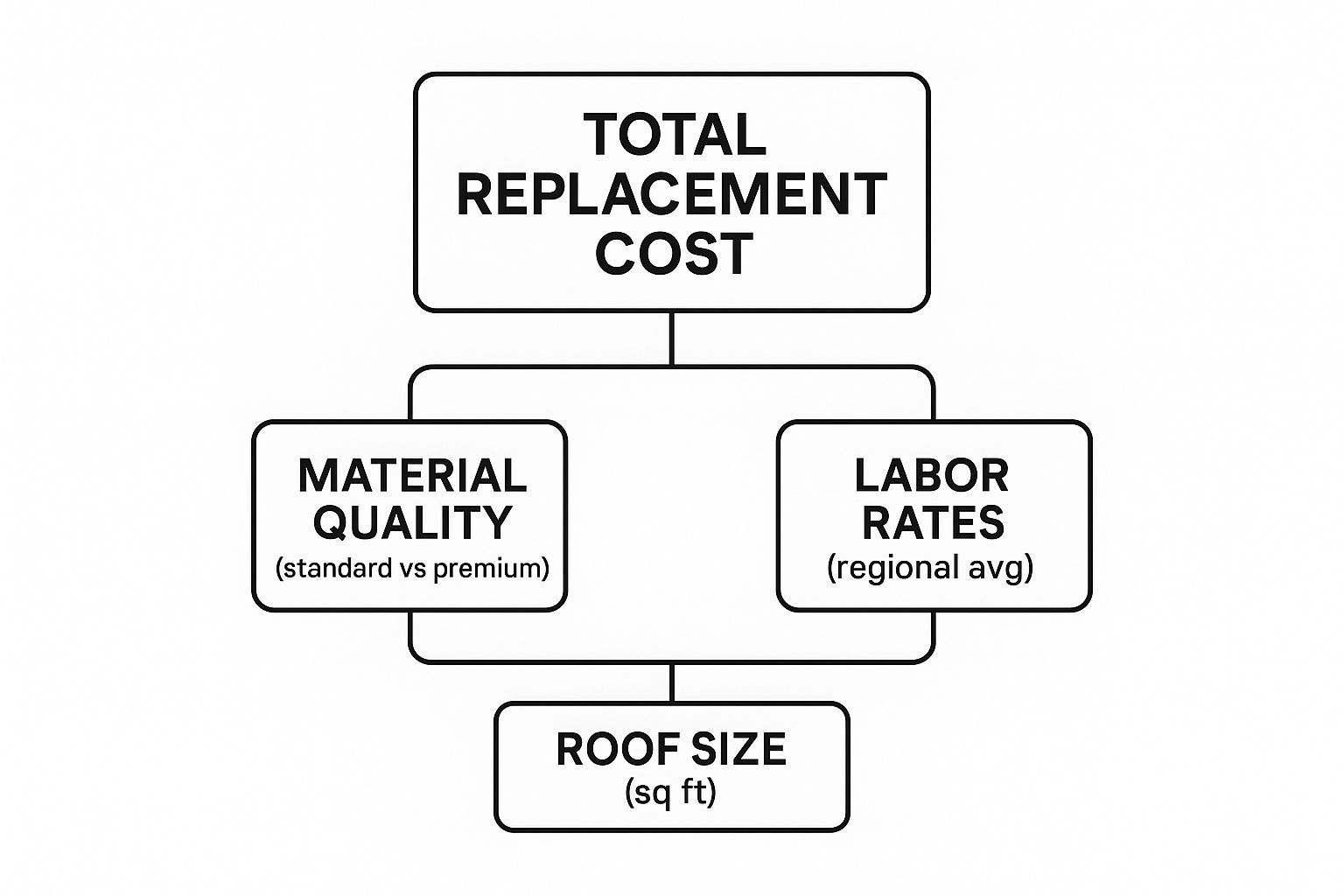
As you can see, the final cost starts with the basic size of your roof and then gets layered with the quality of materials you choose and what labor costs look like in our area.
The Role of Labor and Roof Complexity
Labor costs aren't just an hourly wage; they reflect the skill, risk, and time required for your specific roof. A simple, single-story ranch home with a gentle slope is far less labor-intensive than a two-story house with a steep pitch, multiple dormers, and complex valleys.
The more complex your roof, the more custom cutting, intricate flashing, and safety precautions are required. This specialized work demands more time from an experienced crew, which directly increases your labor costs.
Here’s a checklist of design features that will increase your labor quote:
- Steep Pitch: A steeper roof requires extra safety equipment like harnesses and roof jacks, slowing down the installation process and increasing man-hours.
- Multiple Levels and Valleys: Every valley, dormer, or chimney requires precise flashing and cutting. The more of these features you have, the higher the labor cost.
- Accessibility: If your home is surrounded by landscaping or has limited access for equipment, the crew will need more time for material staging and debris removal, which will be reflected in the bill.
Expert Insight: On most jobs, labor makes up about 40% of the total tile roof replacement cost. For those really steep or architecturally complex roofs, that percentage can easily creep higher.
Overlooked Costs That Add Up
Beyond tiles and labor, several other line items are essential for a professional job. These are often called "hidden" costs, but a transparent contractor will list them clearly in your quote. Make sure your estimate includes the following to avoid surprises.
1. Tear-Off and Disposal
Before the new roof goes on, the old one must be removed. This includes the labor for the tear-off, the cost of an on-site dumpster, and local landfill fees for debris disposal.
2. Underlayment Installation
This is the critical waterproofing barrier between the tiles and your roof's wood deck. In South Florida, building codes mandate high-performance synthetic underlayments designed to withstand hurricane conditions. Do not cut corners here; ensure your quote specifies a code-compliant, self-adhering "peel-and-stick" underlayment.
3. Decking Repair or Replacement
The true condition of the underlying wood sheathing ("decking") is unknown until the old roof is removed. It's common to find rotted spots from previous leaks. Any damaged wood must be replaced to provide a solid foundation for the new tiles. This is typically charged on a per-sheet basis.
4. Permits and Inspections
A roof replacement is major construction requiring a building permit and official inspections. The permit fees and the administrative time to coordinate with city inspectors are legitimate project costs that ensure your new roof is fully compliant with local safety codes.
Choosing Your Tile Material Wisely
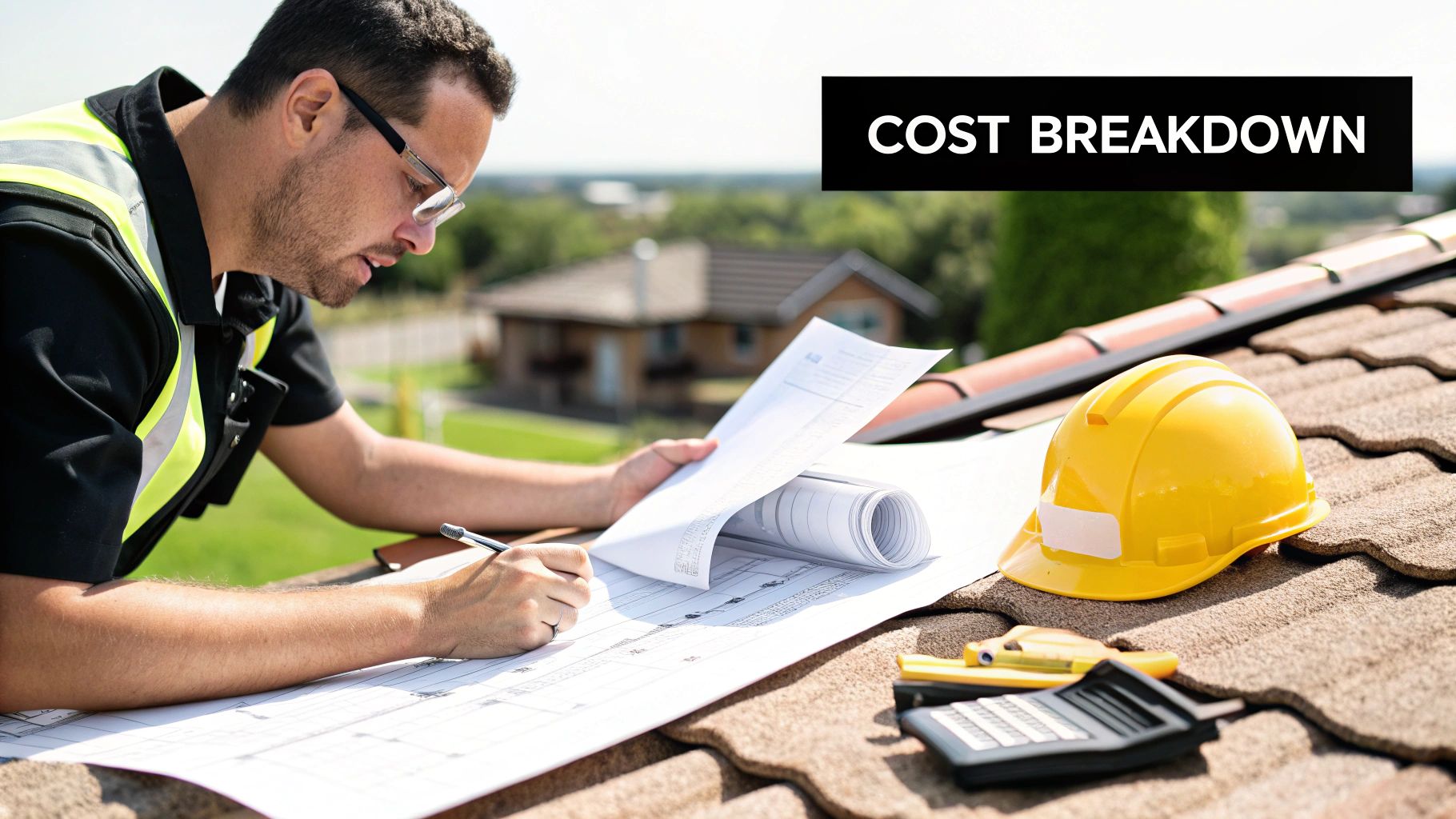
The tile you choose is the heart of your new roof and the biggest line item on your invoice. Making the right choice is an actionable balancing act between aesthetics, performance, and your budget. This decision has the most significant impact on your final tile roof replacement cost.
Your choice comes down to your home's style and your long-term priorities. Let's compare your three main options—concrete, clay, and slate—so you can weigh the upfront investment against the long-term value each provides.
Concrete Tiles: The Durable Workhorse
For the best balance of beauty, durability, and cost-effectiveness, concrete is the go-to choice. Modern manufacturing creates a vast range of shapes and colors that can effectively mimic more expensive materials like clay or wood shake. Concrete tiles are proven to handle South Florida's sun and high winds, making them a smart, practical investment.
- Cost: Typically $8 to $15 per square foot, installed.
- Best For: Homeowners seeking the classic tile look and high durability without the premium cost of clay or slate.
- Key Benefits: Excellent value, high durability, and a wide variety of styles and colors.
- Potential Drawbacks: Can absorb moisture over time, potentially leading to mildew without maintenance. Color may fade slightly after decades of intense sun exposure.
Clay Tiles: The Timeless Classic
When you picture a classic tile roof, you're probably thinking of clay. Renowned for its iconic reddish-orange terracotta color, clay delivers a timeless, upscale look that significantly boosts curb appeal. These tiles are famous for their longevity, often lasting 50 years or more with proper care. This classic aesthetic and durability come with a higher price tag due to material costs and the need for specialized installation skills.
A Matter of Material: Clay's key advantage is its color integrity. The color is baked through the entire tile, not just applied to the surface. This means it will never fade. The color you see on day one is the same color you'll see in 50 years.
This enduring quality justifies the higher cost for many homeowners, guaranteeing the roof's beauty for a lifetime.
Slate Tiles: The Gold Standard
For the ultimate in luxury, durability, and curb appeal, slate is the undisputed champion. As a natural stone, each slate tile is unique, creating a sophisticated look that no manufactured material can replicate. With a potential lifespan of 100 years or more, a slate roof is a true "once-in-a-lifetime" investment. However, this premier performance comes with the highest tile roof replacement cost. Slate's extreme weight often requires structural reinforcement of the home, and installation demands the most skilled—and expensive—roofing artisans.
This interest in long-term roofing is part of a bigger picture. The global market for roofing and tile underlayment is valued at roughly USD 31.0 billion in 2025 and is expected to jump to USD 51.5 billion by 2035. This shows a clear trend toward homeowners choosing more durable, high-performance materials. You can explore additional details about this market growth and its implications.
- Cost: Ranges from $12 to $25+ per square foot, installed.
- Best For: High-end or historic homes where authenticity, maximum lifespan, and a commanding aesthetic are top priorities.
- Key Benefits: Unmatched lifespan, stunning natural beauty, and extreme resistance to fire and weather.
- Potential Drawbacks: The highest upfront cost, significant weight that may require structural engineering, and a very limited pool of qualified installers.
How South Florida's Climate Impacts Your Cost
Installing a tile roof in South Florida is fundamentally different from doing so in a milder climate, and that difference is reflected in the price. Our unique environment, from intense UV exposure to the annual threat of hurricanes, directly increases your final tile roof replacement cost.
A South Florida roof must be an engineered system built to withstand extreme stress. These requirements are not suggestions; they are mandated by some of the nation's strictest building codes, particularly in the High-Velocity Hurricane Zones (HVHZ) of Miami-Dade and Broward counties. These codes are designed to save lives and property.
Hurricane Codes and Required Upgrades
The single biggest local factor increasing your cost is the mandatory hurricane-rated roofing system. After past storms, codes were strengthened to ensure new roofs can withstand extreme wind uplift and driving rain. For you, this means several non-negotiable upgrades are factored into the price.
Here's what a code-compliant roof in our area requires, which adds to the cost:
- Superior Underlayment: Standard felt paper is not permitted. Codes demand a secondary water barrier, typically a "peel-and-stick" synthetic underlayment that seals directly to the roof deck. This creates a robust waterproof shield that protects your home even if some tiles are lost in a storm.
- Specialized Fastening: Tiles must be secured with corrosion-resistant screws, heavy-duty clips, or two-part foam adhesive systems that bond the tiles to the underlayment. This intensive labor prevents tiles from becoming dangerous projectiles in high winds.
- Tougher Inspections: A permitted roof replacement requires multiple inspections at key stages to verify that every component—from the deck nailing to the final tile placement—meets the strict code.
A South Florida tile roof is a complete system engineered for survival. Every layer, from the reinforced decking to the foam-adhered tiles, works together to protect your home. This level of engineering is a primary reason local costs are higher than national averages.
Market Forces and Environmental Challenges
Beyond building codes, other local factors add to your budget. High demand for housing in South Florida creates a competitive market for both materials and skilled labor. This is part of a larger trend, with the global roofing tiles market projected to hit $17.12 billion by 2030, driven by housing needs in fast-growing urban areas like ours. You can read more about these global urbanization trends and see how they ripple down to local prices.
Furthermore, our coastal environment's salt-laden air is highly corrosive. This requires that every metal component on your roof, from fasteners to flashing, be made of more expensive, corrosion-resistant materials like stainless steel or copper to prevent premature failure from rust.
All these climate-driven requirements come together to create a unique pricing reality for a tile roof replacement cost in South Florida.
Practical Ways to Lower Your Roofing Costs
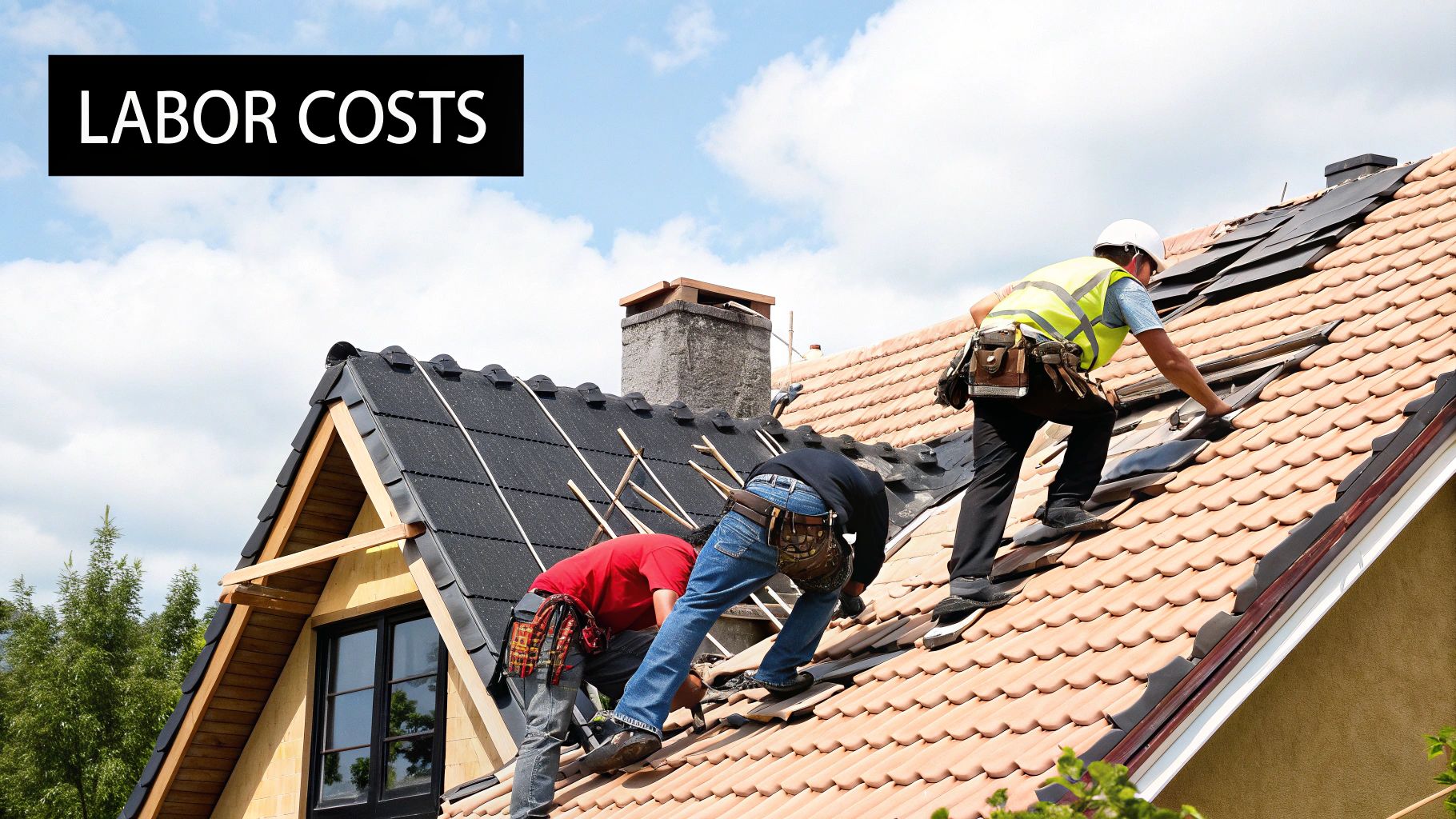
Understanding the factors that drive your tile roof replacement cost is the first step. The next is taking action to manage that cost effectively. By being strategic, you can make this major investment more affordable without compromising on quality or safety.
Here are actionable steps you can take to control your final project cost.
Get Multiple Detailed Quotes
This is your most powerful cost-control tool. Do not accept the first estimate you receive. Your goal is to collect at least three to five detailed quotes from reputable, licensed, and insured local roofing contractors.
Laying out several bids lets you compare pricing for materials, labor, and disposal. This gives you a clear understanding of the fair market rate and provides leverage for negotiation. A contractor is more likely to offer a competitive price when they know you are well-informed and have other options.
Pro Tip: Insist on an "apples-to-apples" comparison. Each quote must specify the exact same brand and type of tile, underlayment, and fastening system. A significantly lower bid is a red flag; they are likely quoting cheaper, non-compliant, or inferior materials.
Think Long Term with Material Choices
It may seem counterintuitive, but spending more upfront on certain materials can lead to significant long-term savings. This is particularly true for your tile selection. While standard concrete tiles have a lower initial cost, upgrading to a tile with energy-efficient features can pay for itself over the life of the roof.
Consider these long-term financial benefits:
- Energy-Efficient Tiles: Ask for "cool roof" tiles with reflective pigments that bounce sunlight away from your home. This reduces the strain on your air conditioning system, leading to lower monthly electric bills.
- Maintenance Costs: Higher-quality clay or slate tiles are less porous and more resistant to algae and mildew growth. This means you'll spend less on professional roof cleanings over the decades.
Ask About Financing and Insurance
A full roof replacement is a major expense. You don't have to pay for it all at once. Ask potential contractors about their financing options, which can break the total cost into manageable monthly payments.
When planning a major project like a new tile roof, you have to think beyond the sticker price and consider how it fits into your whole financial picture. For a deeper dive into managing large home expenses, it's worth checking out resources on understanding your overall financial confidence.
Finally, contact your homeowner's insurance agent. If your current roof was damaged by a covered event like a hurricane or severe hailstorm, your policy might pay for a significant portion of the replacement. It is always worth a phone call to clarify your coverage.
Frequently Asked Roofing Questions
Making a decision about a tile roof replacement involves a lot of money and trust. Getting clear, direct answers to your questions is the best way to feel confident in your investment. Here are the most common questions we hear from homeowners, with actionable answers you can use.
How Long Does a Tile Roof Last Compared to Asphalt Shingles?
This is where tile demonstrates its superior value. An asphalt shingle roof typically lasts 20-30 years in the Florida climate. A professionally installed tile roof dramatically surpasses that.
Clay and concrete tile roofs are engineered to last 50 years or more, while slate can last over a century. Although the initial tile roof replacement cost is higher, you may never have to reroof your home again. In that same 50-year span, a homeowner with a shingle roof could face the same major expense two or even three times.
Will My Home's Structure Need Reinforcement for a Tile Roof?
This is a critical safety question. Tile, especially concrete and slate, is significantly heavier than asphalt shingles. If your home was originally built for a shingle roof, its structure may not be strong enough to support the additional weight.
Action Step: Before signing a contract, ensure your roofer confirms that a structural engineer will inspect your home's framing. They will assess the rafters and trusses to certify the home can handle the load. This is not optional.
Safety First: If the engineer determines reinforcement is needed, it is mandatory. This will add cost and time to the project but is non-negotiable for the safety of your home and family. Any contractor who suggests skipping this step is unqualified and putting you at risk.
Are There Any Hidden Costs I Should Be Aware Of?
Even with a detailed quote, surprises can emerge after the old roof is torn off. The most common unforeseen cost is the discovery of rotted or damaged wood decking. This damaged plywood must be replaced, and it's typically an extra charge priced per sheet.
To prepare, ask your contractor upfront about their process for handling potential issues like:
- Replacing rotted wood decking or fascia boards.
- Bringing roof ventilation up to current building codes.
- Addressing unexpected structural problems.
A reputable contractor will discuss these possibilities with you, include a contingency clause in the contract, and communicate with you immediately if any extra work is required.
Can I Install New Tiles Over My Old Shingle Roof?
No. This practice, known as a "roof-over," is a dangerous shortcut that violates local building codes and voids all warranties. We will never do it.
A complete tear-off of the old roofing material is the only professional method. It is the only way to inspect the underlying wood deck for damage and ensure your new roof is installed on a solid, safe foundation. Insist on a full tear-off to guarantee your new tile roof is safe, code-compliant, and protected for decades to come.
When you're ready to invest in a roof that offers lasting beauty and unparalleled protection for your South Florida home, turn to the experts. The team at Exact Roofing has the experience and dedication to handle your tile roof replacement with precision and care. For a detailed, transparent estimate and the peace of mind that comes with a job done right, contact us today.

